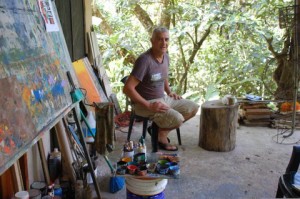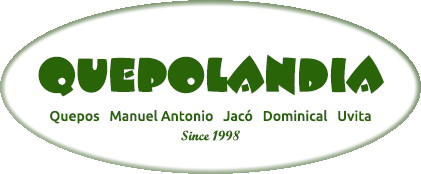Adrián Vallí
(en Español)
By Carol Vlassoff
Picture a modern-day combination of Paul Gaugin, Pablo Picasso and Jacques Cousteau living in Manuel Antonio, and you may be imagining a real personality in our midst. Adrián Valli, known to most as “Adrián, the artist from Argentina,” paints, sculpts, carves and experiments with different art forms in his jungle studio in El Lirio, Manuel Antonio.
I maneuver through a narrow hole in a V-shaped barbed wire fence (“to keep the horses out,” Adrián explains), cross a large patch of grass and descend into a green oasis beyond which a small concrete house nestles in a grove of palms, haleconia blooms and mango trees, dripping orchids and moss. He pulls out a green plastic chair on his patio studio and goes to make coffee while I gaze around me at a paint-spattered canvas, piles of carved fishes, a partially completed Easter Island sculpture, tiles of different colors in plastic water jugs, and a heap of metal objects in the corner. Paint cans of different sizes fill the space below the canvas. It strikes me that, despite an air of casual disarray, there is complete order here. Adrián returns with the coffee, he takes a bite of the doughnut I’ve picked up for him in Quepos, and assures me that the noisy scrambling overhead is just a pair of iguanas fighting on the roof.
Born in Rosario, Argentina, Adrián grew up in the United States. He tells me that his father decided to leave Argentina in 1959, when Adrián was only two, to escape the military junta. Thanks to help from an Argentine friend in California., his father worked as a sign painter to make ends meet. Eventually he purchased a sign shop where Adrián learned the ropes. “We ran the business from home,” Adrián recalls, “by adding an extension to our garage. We did big wall murals, vehicles, all types of signs, everything hand painted. I learned how to do lettering and started doing murals on my own.” At the age of 22 he opened up his own shop, the North County Sign Company, in Leucadia, a coastal town in North San Diego County.
Vallí says he always loved the sea and dreamed of moving somewhere far from the pressures and stress of urban life. Fiji was high on his list. He did visit Fiji where, he confesses, he fell in love with the crystal clear water and the coral. ” It felt like living in a salt water aquarium. I almost leased an island.” One day, though, a Fijian chief paid him a visit and claimed part of the land. “I changed my mind about leasing it,” he laughs. “Who knew how many more chiefs might still show up?”
In 1990 he visited Manuel Antonio on vacation. He says he liked the peninsula, the coast and the bays and started asking around about the cost of property here. Someone showed him a plot of land in El Lirio and that was the beginning of his attachment to Costa Rica. “Here you can actually hear the waves when they break,” he tells me. He points up at a hill in the distance and says, “There is the Kilamanjaro of Manuel Antonio. It’s higher than the Plinio tower. ” He returned to California, where he sold his shop and moved to Costa Rica in 1992.
I ask how he got started in his business. “I did signs at first, hand lettering on fishing boats, signs for businesses, things like that. Then I started getting into fish sculptures, walls murals, then cement sculptures, waterfalls, even artificial rocks. I learned how to make them look natural with lichen growing on them.” He has never had a marketing plan, nor any means of promoting his art, but he says that his business has survived through word of mouth and referrals. “Most of my paintings have ended up outside the country,” he says.
Adrián says he is stimulated by the environment. “ I’m not stressed out here. I can concentrate. I love to paint so much! It just energizes me. Painting requires light, subject matter, composition, texture. It’s a full time job to create an interesting piece of art that people want to buy.” One of the things he likes best about working here is meeting people from all over the world. He mentions selling art to a group of people from Iceland, a place he has never been, and thinking of them looking at it on the wall and remembering Costa Rica. He often receives messages from people who have bought his art. “One client I shipped an order to wrote and said how pleased he was with the piece, and told me that even the tube I sent it in smelled like Costa Rica.”
Although he continues to receive orders for specific projects, Adrián says he likes to try new things, research new art forms. Currently he is experimenting with Giclée prints, or high quality ink-jet prints, to make reproductions of his original paintings. He is making three series of these, on the ocean, jungle and reptiles. His inspiration for his art comes mainly from Costa Rica and his immediate surroundings, including the Manuel Antonio coast where he dives and surfs when the swell is high. (Later he shows me his magnificent collection of seashells, some of which he collected locally, that he curates and trades.)
He says that the best experience in his professional life was a vernissage in Paris, complete with press coverage. “For me it was a big thing! Parisians bought my stuff!” Altogether he sold five pieces. He also loved Paris, especially the Picasso museum. Picasso, he says, is his biggest inspiration because he changed art more profoundly than any other artist of this century. During his career, he created thousands of works, not only paintings but also sculptures, prints and ceramics, using all kinds of materials. First famous for his pioneering role in Cubism, Picasso continued to develop his art, each change embodying a radical new idea. “He said there is no substitute for good drawing,” Vallí remarks. “I always remember this.”
I ask about the changes he has seen in the area over his 19 years here. He glances at the trunk of a huge mango tree next to his house and says that there has been too much development in area, development that has not been properly controlled. “I don’t believe in ripping out the jungle. I like to keep my trees.” On the positive side, he mentions meeting visitors to Costa Rica, most of whom are nature lovers, interested in preserving the environment. Another positive aspect is the greater availability of things today, such as a variety of art supplies. “Just look at all these colors,” he says, sweeping his arm in the direction of his many paint cans. “You can make your own colors. Thousands of shades of colors!”
So what about the future? How long does he plan to continue his life in the jungle of Manuel Antonio? Adrián hesitates. “We all have a life span. It’s coming up on 20 years since I’ve been here. The ocean keeps drawing me. I love the South Seas.” And then he looks around and smiles, “But this is my little garden of Eden.”
After saying goodbye, I turn back to look at the artist’s small cottage and I am struck by a paradox in what I’ve been told. Vallí claims to have patterned his career after Picasso’s, and indeed there are parallels. Yet in his fascination with the sea, his seashell collection, his intricately crafted wooden fish, his painting of a Medusa jellyfish, he shares a deep connection with Cousteau. The brilliant colors that fill his canvas, painting in a grotto of green and reminiscing of the South Seas, bear a strong resemblance to Gaugin. And I think how fortunate we are to live here where, only a short distance from Quepos or Manuel Antonio Beach, we can find such a person as Adrián Vallí, whose art is known throughout the Americas and in parts of Europe, and that he has chosen to live among us.
*The artist can be contacted at oddiercr@yahoo.com. Watch a short video of Adrián at work here.
